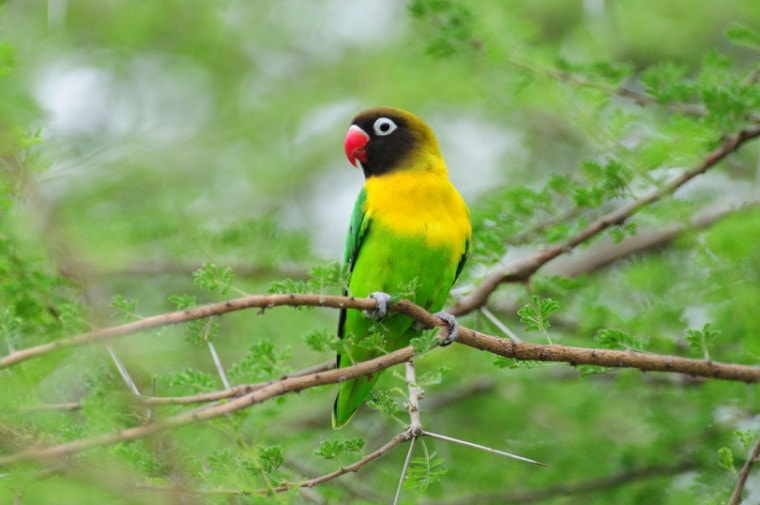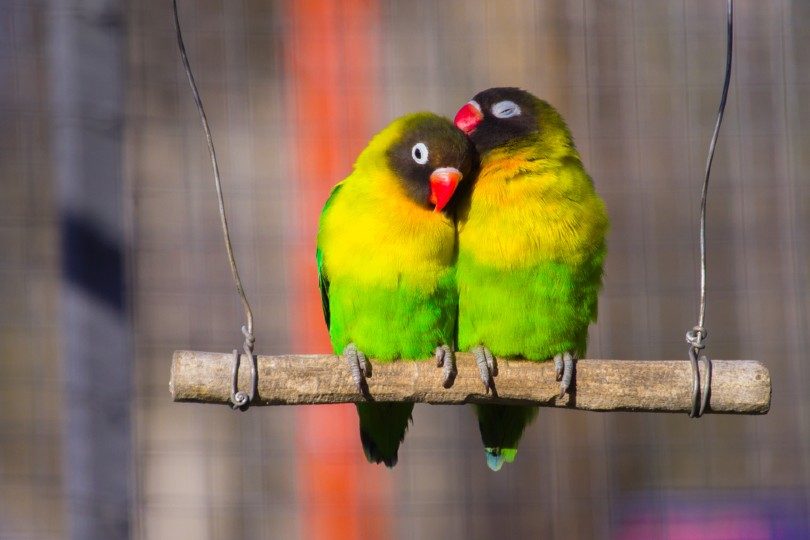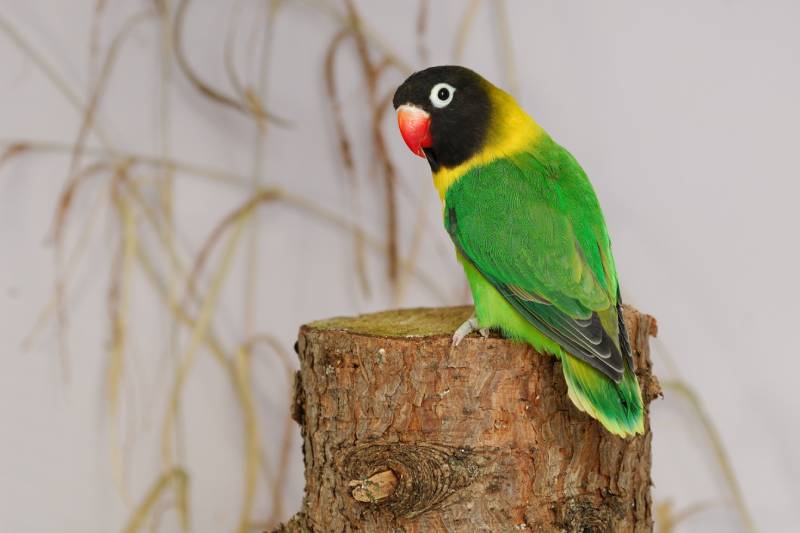
The masked lovebird is a particular species of lovebird. These birds are a part of the parrot family and are native to northeast Tanzania.
This species is similar in temperament to other lovebirds. They are well-known for their energetic nature. However, their small size makes them easier to keep despite their high activity level. They are pretty cute and interact quite well with people of all sorts.
These birds are very healthy and can be kept together easily. It is often recommended to purchase more than one, as they do best with plenty of social interaction. These birds create a lasting friendship with others, including other lovebirds and people.
 Yellow-Collared (Masked) Lovebird Overview
Yellow-Collared (Masked) Lovebird Overview

| Common Names: | Yellow-Collared Lovebird, Masked Lovebird |
| Scientific Name: | Agapornis personatus |
| Adult Size: | 5.5 inches |
| Life Expectancy: | 10 to 15 years |
Origin and History
There are many different species of lovebirds. They are all native to the African continent (except one, which lives in Madagascar) and live in flocks. The masked lovebird is mainly native to northeast Tanzania. However, it has been introduced to different areas as well, such as Burundi and Kenya. Breeding has occurred in these areas, so this species is now considered “established” in these areas.
They have been observed in the wilds of Puerto Rico. However, these are likely the result of escaped pets. No reproduction has been spotted, so they likely aren’t established. The same can be said for Arizona, where some wild birds have also been spotted.
These birds have been kept in captivity for a very long time. Most birds sold today were bred in captivity, though some are still captured in the wild.
Temperament

This particular species of lovebird is known for being less aggressive than others. They can easily be housed with birds of other lovebird species. They often bond quickly with these other birds. Often, this can lead to hybridization. Some people consider this a bad thing, while others don’t see it as a problem.
These birds usually need to be housed in colonies. They will not thrive by themselves, even with plenty of attention from their people. They are an extremely social species.
Masked lovebirds are very active and playful. They are much more interactive than other bird species due to their social behaviors.
Proper socialization is essential from a young age. If they are not handled and interacted with often, they can become territorial and aggressive. Their temperament can vary depending on the gender of the bird. Female lovebirds may be slightly more aggressive and even jealous when compared to males. They may also be more territorial, which means that it may be more challenging to keep them in homes with other birds.
However, some argue that there isn’t a gender difference in temperament.
Speech and Vocalizations
Lovebirds are not as loud as some other species. They can produce a high-pitched scream in some situations, particularly when they are looking for attention. Their normal vocalizations are very quiet, though, but you shouldn’t plan on them not making any noise at all.
They are known for their ability to mimic different sounds. Females tend to be better at mimicking sounds than males, but many males can mimic sounds and speech as well. Both sexes will chatter somewhat.
The birds’ vocalizations often vary from individual to individual. Some are far more vocal than others. It is a personality trait that varies.
Yellow-Collared (Masked) Lovebird Colors and Markings
These tiny birds only reach about 5.5 inches long. Their bottom half is dark green, but they have a “yellow” collar around their mouth. Their faces are black, hence why they are sometimes called “masked” lovebirds. Their beaks are bright red, and they have white eye-rings.
Males and females look the same. There is no way to tell a bird’s gender based on its appearance.
Some color variants are the result of genetic changes.

Caring for the Yellow-Collared (Masked) Lovebird
Lovebirds are one of the easiest birds to take care of. However, they do have some specific needs. Plenty of handling and training is necessary to keep them tame. Otherwise, they can become aggressive and territorial. These birds are not the friendliest, but they can be managed with proper socialization.
It is easiest to purchase a hand-raised fledgling, as these have already had a lot of handling. However, any lovebird can technically be tamed if you have enough time and patience. Either way, the bird probably won’t like you very much at first. It takes a lot of exposure before these birds feel comfortable with new owners.
These birds require a lot of social interaction. This is why it is recommended that they are kept in pairs. Often, owners don’t have the time or energy to provide them with all the attention they need. If you have a day job, you probably don’t have the time to provide your bird with the proper attention. Therefore, a mate will probably be beneficial.
With that said, they can be kept alone if they are given enough attention. They require quite a bit of social interaction, so you should plan on interacting with a lovebird for hours a day if they are by themselves.
Common Health Problems
Lovebirds are usually pretty healthy. They usually don’t develop problems unless they are housed improperly. However, they are prone to a few common bird illnesses.
Signs of illnesses include social withdrawal, ruffled feathers, dull plumage, fatigue, watery eyes, runny nose, excess sleeping, and loss of interest. A sick bird often won’t leave the feed dish. Because these birds are so social, withdrawal from social interaction is often a sure sign that they are sickly. We highly recommend taking your bird to a vet if you recognize any of these problems.
These birds are prone to respiratory problems and various viral infections. Often, it isn’t easy to treat a bird at home. Most birds will display similar symptoms for most illnesses, so diagnosing based on symptoms alone may not be completely accurate.
Having an exotic vet near you is essential to maintaining their health. Locate your nearest vet before deciding to move forward with adoption. If the vet is further away than you are willing to drive, you should reconsider getting a bird.
Diet and Nutrition
Like most birds, lovebirds require a variety of foods. In the wild, these birds feed on fruits, grasses, seeds, and veggies. They will eat whatever they can get their hands on. Most of the time, their diet will differ depending on their location and the time of year.
You should aim to keep your bird’s diet noticeably diverse. Seeds should make up less than 25% of a lovebird’s diet. Most birds love seeds, but they do not provide complete nutrition. They are also very high in fat, which isn’t particularly healthy for a bird.
The base of their diet should be high-quality pellet bird food. These are often designed with the correct nutrients that these birds need to ensure complete and balanced nutrition. Fresh foods should supplement the diet, including a wide array of fruits. Be sure only to feed your bird-safe fruits.
Rotate the fresh foods that you offer. This will increase the variety of vitamins and nutrients that your bird eats, improving their overall health. Your lovebird may need time to adjust to new foods, so expect them to be a bit unsure at first. A cuttlebone bird treat should be provided for extra calcium.
Exercise
Lovebirds are pretty playful. They don’t spend much time staying still, which is one reason why they are very interactive. They are always doing something. These birds thrive on interaction and playtime. They are not birds that you just sit around and watch. Use this dynamic behavior to help build your bond. They often get a lot of enjoyment out of interacting with others.
You should have many toys on hand and cycle through them regularly. While they do love toys, they can become bored when the same toys are offered constantly. It is a good idea to switch stuff out every two weeks for novelty. Once a toy has been out of sight for a bit, the lovebird often won’t remember it.
These birds are very aggressive chewers. Their jaws aren’t quite as strong as other birds, but they can do a bit of damage. Keep this in mind when picking out things for their cage. You don’t want anything that may break easily. Avoid loose strings and other small things that your bird may become trapped in.
Where to Adopt or Buy a Yellow-Collared (Masked) Lovebird
These birds are usually pretty easy to locate. Most pet stores sell them, though it is often better to purchase from a breeder. These birds are not terribly expensive, but certain color variants might be. Albino and similar variants may not be widely available. You usually have to purchase these from breeders.
If you’re looking for a particular type of masked lovebird, you may have to have it transported. Most of the birds produced by breeders are normal variants. Only particular breeders focus on specific color variants.
An average masked lovebird may cost as much as $150. However, most are closer to the $100 range. The quality of the bird matters. Those that have been handled more and are friendlier will often be more expensive.
 Final Thoughts
Final Thoughts
Masked lovebirds are a particular species of lovebird. They are known for their vibrant green and yellow coloration. They are incredibly social birds, like most lovebirds. However, they are not particularly friendly with people unless they are handled a lot. Therefore, we recommend purchasing hand-raised fledglings and interacting with your bird a lot.
This species requires a lot of attention. Some owners can provide their birds with enough attention. However, others find this difficult. For this reason, they are often kept in pairs. They are flock birds, so they do best when kept with lots of other birds.
Related Reads:
- Black-Collared Lovebird: Traits, History, & Care (with Pictures)
- 10 Types of Pet Parrots: Care Tips, Facts & Pictures (Our Vet Answers)
Featured Image Credit: Rich Lindie, Shutterstock
 Yellow-Collared (Masked) Lovebird Overview
Yellow-Collared (Masked) Lovebird Overview







